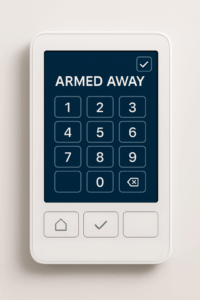The alarm keypad is the cornerstone of any effective security system, providing users with the essential interface for managing their home’s or business’s protection. It simplifies arming, disarming, and monitoring various security elements, offering peace of mind through centralized control. This comprehensive guide from Cunningham Security explores the fundamental purpose of keypads, their functionalities, proper placement for maximum effectiveness, and professional tips for optimal usage, ensuring your property remains secure and accessible at all times.
Table of Contents
- What is an Alarm System Keypad?
- Purpose of a Keypad in an Alarm System
- How Does a Keypad Work?
- Proper Placement of an Alarm Keypad During Installation
- Why You Should Include a Keypad in Your Alarm System
- Keypad Compatibility and Installation Guidance
What is an Alarm System Keypad?
For many homeowners and business owners, the keypad is the most recognizable and frequently used component of their alarm system. It provides the primary point of interaction between users and their security system, enabling control, monitoring, and programming of the entire alarm system through a simple interface. Essentially, the keypad serves as the command center or control hub of the entire alarm setup.
Purpose of a Keypad in an Alarm System
The keypad acts as the central control interface for your entire security system, allowing users to conveniently arm and disarm the alarm. All security equipment—such as motion detectors, door and window sensors, cameras, flood sensors, and more—send signals to this central panel, providing a unified location where vital system information is displayed clearly to the user. Without a keypad, it would be difficult to quickly identify the exact location of security events like opened doors or detected floods, making prompt action challenging. A keypad effectively resolves these issues by clearly indicating exactly what the sensors are detecting at any given moment.
How Does a Keypad Work?
Keypad Codes and System Arming Modes
Alarm keypads generally feature a numeric interface similar to a telephone keypad, including digits 0 through 9, as well as special keys such as the pound (#) and asterisk (*). Users input a unique security code into the keypad to easily arm or disarm their system. This prevents unauthorized access and reduces the risk of false alarms. Keypads typically offer different arming modes, such as “Away Mode” (arming all sensors when leaving the premises) and “Stay Mode” (arming perimeter sensors only while inside, allowing interior movement without setting off alarms).
Keypad Display Features
Most modern keypads include an LCD screen or touchscreen display, presenting detailed information clearly. The display highlights real-time sensor status, such as which doors or windows are open, and any active alerts from motion or flood sensors. Advanced touchscreen keypads provide additional options, settings, and graphical interfaces that improve user-friendliness and accessibility.
Touchscreen keypads provide users with intuitive, user-friendly interfaces and enhanced functionality. These modern touchscreen keypads simplify navigation and control by offering clear visual icons and interactive menus, similar to a smartphone or tablet. The responsive nature of touchscreens makes programming, arming, disarming, and monitoring security systems more straightforward and accessible for users of all technical backgrounds. Additionally, touchscreen keypads often support advanced features such as integrated home automation controls, real-time video viewing, and detailed sensor status updates, significantly enhancing the user experience and overall effectiveness of modern security systems.
Proper Placement of an Alarm Keypad During Installation
The keypad must be placed strategically to ensure quick and convenient access. Ideal locations include frequently used entry points, such as the front or side door, or adjacent to garage entry points, where users can disarm the alarm immediately upon entering. Homes or businesses with larger layouts might benefit from multiple keypads placed near each major entry point, simplifying access and reducing the risk of false alarms due to delayed disarming.
When installing your alarm system, carefully consider which entry points are most often used. This ensures keypad placement facilitates quick disarming immediately upon entering your premises, minimizing inconvenience and reducing false alarm incidents.
Why You Should Include a Keypad in Your Alarm System
A keypad is fundamental to an effective alarm system. Without it, sensors would merely detect events silently without alerting you or providing meaningful insights about the event locations. The keypad consolidates alerts and sensor data into one clear interface, enabling swift responses to any security event. This centralization significantly enhances overall convenience, effectiveness, and usability of your security system, reinforcing the keypad’s critical role in home and business security.
Your Cellphone as a Virtual Keypad
Your cellphone can serve as a powerful virtual keypad, giving you convenient, remote access to control and monitor many aspects of your alarm system. Through intuitive security apps, you can easily arm or disarm your system, view real-time alerts, and manage your home’s safety from virtually anywhere. Additionally, many modern security platforms integrate seamlessly with home automation technologies, enabling your smartphone to adjust lighting, thermostats, door locks, and even video cameras with just a few taps. This level of mobile integration not only enhances security but also provides unmatched convenience and peace of mind, allowing you to stay connected and in control whether you’re at home, at work, or on vacation.
Keypad Compatibility and Installation Guidance
It’s important to understand that keypads can vary considerably in their features, compatibility, and usability depending on the brand and specific security system you use. Ensuring compatibility between your keypad and other alarm components is crucial. Always consult with professionals during installation or system upgrades to verify compatibility and functionality. Manufacturer manuals or professional installers can provide necessary guidance for programming and customizing your keypad features. If your manual isn’t immediately available, reputable security providers, such as Cunningham Security, offer easy access to digital versions, ensuring smooth installation and continued support.
Ready to enhance your security system with a reliable, easy-to-use keypad? Contact Cunningham Security today to discuss keypad installation options and ensure your home or business remains secure and fully monitored.
